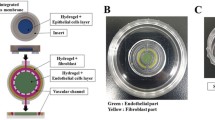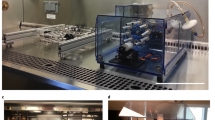Abstract
While there are many chip models that simulate the air-tissue interface of the respiratory system, only a few represent the upper respiratory system. These chips are restricted to unidirectional flow patterns that are not comparable to the highly dynamic and variable flow patterns found in the native nasal cavity. Here we describe the development of a tunable nose-on-chip device that mimics the air-mucosa interface and is coupled to an air delivery system that simulates natural breathing patterns through the generation of bi-directional air flow. Additionally, we employ computational modeling to demonstrate how the device design can be tuned to replicate desired mechanical characteristics within specific regions of the human nasal cavity. We also demonstrate how to culture human nasal epithelial cell line RPMI 2650 within the lab-on-chip (LOC) device. Lastly, Alcian Blue histological staining was performed to label mucin proteins, which play important roles in mucous secretion. Our results revealed that dynamic flow conditions can increase mucous secretion for RPMI 2650 cells, when compared to no flow, or stationary, conditions.




Similar content being viewed by others
References
A. Mistry, S. Stolnik, L. Illum, Int. J. Pharm. 379, 146–157 (2009)
S. Bai, T. Yang, T.J. Abbruscato, F. Ahsan, J. Pharm. Sci. (2007)
C. Mercier, N. Perek, X. Delavenne, Eur. J. Drug Metab. Pharmacokinet. 43, 13–24 (2018)
S. Reichl, K. Becker, J. Pharm. Pharmacol. 64, 1621–1630 (2012)
A. Wengst, S. Reichl, Eur. J. Pharm. Biopharm. 74, 290–297 (2010)
N. Even-Tzur, D. Elad, U. Zaretsky, S.H. Randell, R. Haklai, M. Wolf, Ann. Biomed. Eng. 34, 1890–1895 (2006)
N. Even-Tzur, Y. Kloog, M. Wolf, D. Elad, Biophys. J. 95, 2998–3008 (2008)
S. Ladel, P. Schlossbauer, J. Flamm, H. Luksch, B. Mizaikoff, K. Schindowski, Pharmaceutics. (2019)
T. Shimizu, H. Hirano, S. Shimizu, C. Kishioka, Y. Sakakura, Y. Majima, Am. J. Respir. Crit. Care Med. 164, 1077–1082 (2001)
A. Yuta, W.J. Doyle, E. Gaumond, M. Ali, L. Tamarkin, J.N. Baraniuk, M. Van Deusen, S. Cohen, D.P. Skoner, Am. J. Physiol. - Lung Cell. Mol. Physiol. (1998)
M. Kaliner, J.H. Shelhamer, B. Borson, J. Nadel, C. Patow, Z. Marom, Am. Rev. Respir. Dis. 134, 612–621 (1986)
A. Lechanteur, J. das Neves, B. Sarmento, Adv. Drug Deliv. Rev. 124, 50–63 (2018)
M. Pozzoli, F. Sonvico, H.X. Ong, D. Traini, M. Bebawy, P.M. Young, in Respiratory Drug Delivery (2014)
S. Grau-Bartual, A.M. Al-Jumaily, P.M. Young, D. Traini, and M. Ghadiri, Eur. Respir. Soc. (2019)
K. Na, M. Lee, H. Shin, S.C.-L. on a Chip, U. 2017, Lab Chip 17, 1578–1584 (2017)
W. Wang, Y. Yan, C.W. Li, H.M. Xia, S.S. Chao, D.Y. Wang, Z.P. Wang, Lab Chip 14, 677–680 (2014)
X.A. Figueroa, G.A. Cooksey, S.V. Votaw, L.F. Horowitz, A. Folch, Lab Chip (2010)
T. Datta-Chaudhuri, R.C. Araneda, P. Abshire, E. Smela, Sensors Actuators, B Chem. (2016)
K. Keyhani, P.W. Scherer, M.M. Mozell, J. Biomech. Eng. 117, 429–441 (1995)
C. Li, A.A. Farag, G. Maza, S. McGhee, M.A. Ciccone, B. Deshpande, E.A. Pribitkin, B.A. Otto, K. Zhao, Int. Forum Allergy Rhinol. 8, 444–452 (2018)
J.T. Kelly, A.K. Prasad, A.S. Wexler, J. Appl. Physiol. 89, 323–337 (2000)
I. Hahn, P.W. Scherer, M.M. Mozell, J. Appl. Physiol. 75, 2273–2287 (1993)
K. Zhao, J. Jiang, Int. Forum Allergy Rhinol. 4, 435–446 (2014)
D. Elad, S. Naftali, M. Rosenfeld, M. Wolf, J. Appl. Physiol. 100, 1003–1010 (2006)
D. Huh, B.D. Matthews, A. Mammoto, M. Montoya-Zavala, H. Yuan Hsin, D.E. Ingber, Science 328(5986), 1662–1668 (2010)
D. Trieu, T.K. Waddell, A.P. McGuigan, Biomicrofluidics 8, 1–14 (2014)
D. Erickson, Microfluid. Nanofluidics (2005)
D.A. Boy, F. Gibou, S. Pennathur, Lab Chip 8, 1424–1431 (2008)
M. Pozzoli, H.X. Ong, L. Morgan, M. Sukkar, D. Traini, P.M. Young, F. Sonvico, Eur. J. Pharm. Biopharm. 107, 223–233 (2016)
P. Dey, Basic and Advanced Laboratory Techniques in Histopathology and Cytology (2018)
J.T. Berger, J.A. Voynow, K.W. Peters, M.C. Rose, Am. J. Respir. Cell Mol. Biol. 20, 500–510 (1999)
M.E.S. Ali, D.M. Bulmer, P.W. Dettmar, J.P. Pearson, Int. J. Otolaryngol. (2014)
S. Gänger, K. Schindowski, Pharmaceutics 10, 116 (2018)
M.Y. Di, Z. Jiang, Z.Q. Gao, Z. Li, Y.R. An, W. Lv, PLoS One 8, e84243 (2013)
Acknowledgements
We appreciate David Mohl (WPAFB) for his advice on development of airflow generation systems. We are grateful to Joe Althaus, Tom Mitchell, and Logan Rowland, MakerHub staff (Wright Brothers Institute, Dayton, OH) for their guidance and assistance with 3D printing. Angela Dixon, Ph.D., was supported by a National Research Council Research Assistantship and Zachary Brooks, M.S., by a Defense Associated Graduate Student Innovators (DAGSI) Graduate Fellowship. This material is based on research sponsored by the Air Force Research Laboratory and the Southwestern Council for Higher Education under agreement FA8650-19-2-9300. The U.S. Government is authorized to reproduce and distribute reprints for Governmental purposes notwithstanding any copyright notation thereon. The views and conclusions contained herein are those of the authors and should not be interpreted as necessarily representing the official policies or endorsements, either expressed or implied, of Southwestern Ohio Council for Higher Education and the Air Force Research Laboratory (AFRL) or the U.S. Government.
Funding
This material is based on research sponsored by the Air Force Research Laboratory and the Southwestern Council for Higher Education under agreement FA8650-19–2-9300.
Author information
Authors and Affiliations
Corresponding authors
Ethics declarations
Conflict of interest
The authors declare that they have no conflict of interest.
Additional information
Publisher's Note
Springer Nature remains neutral with regard to jurisdictional claims in published maps and institutional affiliations.
Supplementary information
Below is the link to the electronic supplementary material.
Rights and permissions
About this article
Cite this article
Brooks, Z., Kim, K., Zhao, K. et al. 3D printed transwell-integrated nose-on-chip model to evaluate effects of air flow-induced mechanical stresses on mucous secretion. Biomed Microdevices 24, 8 (2022). https://doi.org/10.1007/s10544-021-00602-y
Accepted:
Published:
DOI: https://doi.org/10.1007/s10544-021-00602-y




